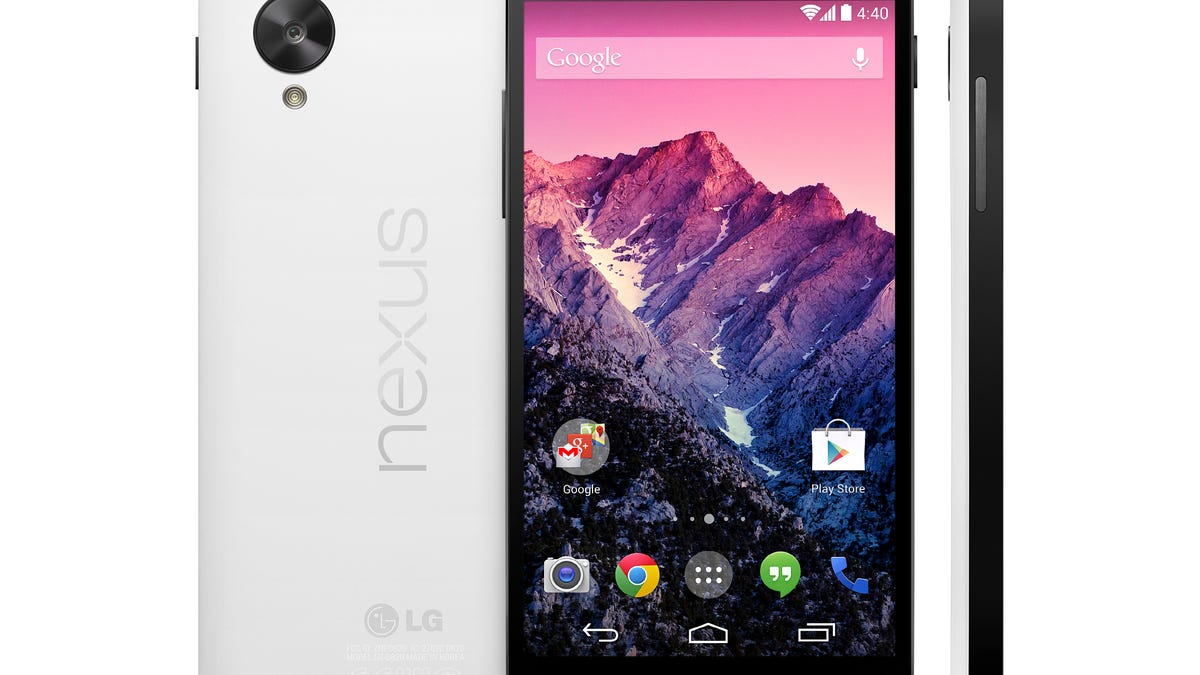Google's $349 Nexus 5 hits today with LTE, KitKat
The Web giant says KitKat can run on lower memory requirements, which means it can ship on low-end phones as well as high-end ones. That should help with Android's fragmentation problem, the company says.

Sundar Pichai, head of Google's Chrome and Android businesses, said the company focused on three themes for Android 4.4, also known as
Check out CNET's take on the Nexus 5.
"Our vision for computing is to design Android as something that can run across all devices, not just the phone," Pichai said during a press briefing Thursday. "But it's important to get Android on the same version that can scale across all form factors. KitKat represents the first big step in that direction."
New features of that operating system include a redesigned dialer that allows users to search for any number, even if it's not in their phone books. For example, users can start typing the name of a restaurant and see the number appear in their list. In addition, search results or queries now pull data from apps as well as the Web. A search for a restaurant, for example, could include an app in the search results.
The unified search is the first step Google has taken in bringing together Chrome and Android, Pichai said.
In terms of components, the
The device costs $349 for 16GB or $399 for 32GB unlocked and is available in two colors, white and black. It's on sale in 10 countries through the Google Play store and also will sell at retailers such as Best Buy and RadioShack and at carrier stores. The phone will work on AT&T, T-Mobile, and Sprint, but is not compatible with Verizon.
Like the Nexus 4, the Nexus 5 is manufactured by LG under Google's guidance. Google has continued to partner with a variety of handset vendors on Nexus devices despite recently buying Motorola Mobility. For some, like LG, that has helped boost their positions against giants such as Apple and Samsung.Google's Nexus phones have slowly gained in popularity, with Android fans gravitating toward them because they include the latest version of Android. In addition, their "pure Android" features attract many people looking to avoid skins like Samsung's TouchWiz interface. And their lower selling prices also make them appealing, particularly when high-end smartphones retail for $600 or more off-contract.
The Nexus 4 sold out in less than half an hour the day it was released a year ago. Inventory for the device remained low for months afterward, with buyers forced to wait many weeks for the device to go back in stock online. The popularity came despite the fact the Nexus 4 didn't offer 4G LTE capabilities, something that had become standard with smartphones.
Google remained fairly secretive about KitKat during the development process. Officially, it only said that its goal with KitKat was to "make an amazing Android experience available for everybody." Many believed that meant new Android-powered devices such as game consoles, smartwatches, smart TV, and laptops. Others looked for a kinder, gentler platform that plays nice with older hardware.
In reality, KitKat places more emphasis on Google's smarts, such as being able to predict what users want before they ask. If someone searches for related topics often, a Google Now card will appear with information about that topic -- such as solar panels -- without having to search. Or if someone is interested in a TV show or other hobby, a Google Now card can appear with information about that item.
To "get Android to work for the next billion people," Google made KitKat compatible with lower memory requirements -- 512MB -- than other recent Android versions," Pichai said. That means low-end phone makers can load KitKat onto their phones, rather than run older versions. Pichai noted that most phones in emerging markets
still ship with Gingerbread, which can't even run the Chrome browser.
"If you look at emerging markets ... Android is growing at three-times the rate of developed markets," Pichai said. "It's pretty stunning growth, and we want to make sure it works great."
KitKat also unifies text messages and Hangouts in one place. And it improves voice search, allowing users to have back-and-forth conversations with Google. For example, someone could ask Google to "call Jennifer." The phone would then ask, "Which Jennifer," and so on.
One KitKat feature unique to the Nexus 5 is the launcher. It shows a translucent Google search bar on every screen. By swiping from left to right, users are able to access Google Now. That features new cards that give people information related to common searches and interests.
Updated at 11:45 a.m. PT with more details and fixes pricing information at 3:10 p.m. PT.
